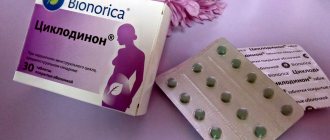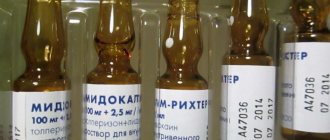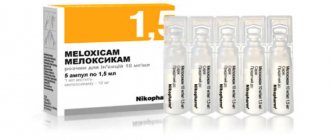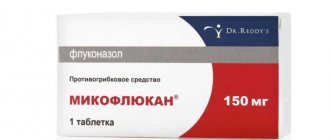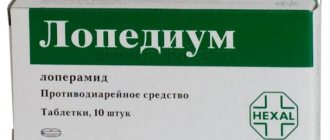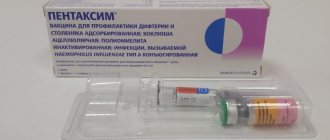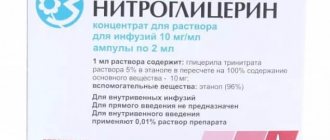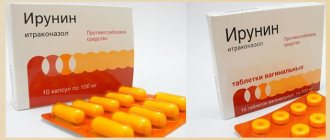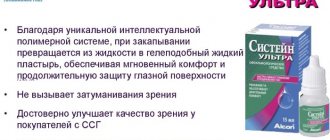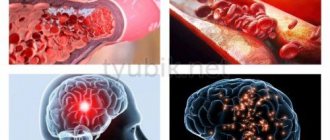In this article we will look at the side effects of Pentalgin. This is a medicine of a combined composition that has analgesic, antispasmodic, antipyretic and anti-inflammatory effects.
The dosage form of this pharmacological agent is film-coated tablets, which are distinguished by a capsule-shaped biconvex shape, beveled edges, and green color. The tablet may have white spots on the cut surface. Tablets are packaged in 12, 10, 6 or 2 pieces in blister packs, as well as in cardboard boxes of 1 or 2 blisters.
The active ingredients contained in the tablets are:
- paracetamol;
- naproxen;
- pheniramine maleate;
- caffeine;
- drotaverine hydrochloride.
The following additional components are used in the production of the medicine: citric acid monohydrate, croscarmellose sodium, magnesium stearate, potato starch, microcrystalline cellulose, talc, butylated hydroxytoluene, hyprolose (Klucel EF), quinoline yellow dye, indigo carmine.
The content of the film shell contains: povidone (medical medium molecular weight polyvinylpyrrolidone), titanium dioxide, indigo carmine, hydroxypropyl methylcellulose, yellow quinoline dye, polysorbate 80, talc. What are the side effects of Pentalgin tablets is interesting to many.
Pentalgin: key characteristics
The drug works on 5 substances. The most famous is drotaverine, the main component of No-Shpa, which is an antispasmodic. Paracetamol is in most cases used as an antipyretic substance, but at the same time it also has a weak analgesic effect. Other main components of Pentalgin:
- Caffeine. A psychostimulant that tones the body, dilates blood vessels, and also enhances the effect of analgesics. In Pentalgin, it also neutralizes the hypotensive effect of drotaverine, so blood pressure drops less frequently when taking the tablet than when using No-Shpa.
- Naproxen. A non-steroidal anti-inflammatory substance that suppresses the production of prostaglandins and thereby reduces pain.
- Pheniramine. It is an H1-blocker of histamine, necessary to enhance the effect of analgesic components.
Thanks to this composition, Pentalgin has a very wide spectrum of action: it can cope with pain that is associated with muscle spasms, vascular, and inflammatory processes. For this reason, it is used in dental, gynecological, and gastroenterological practice. However, keep in mind that the drug does not cure, but only blocks the symptoms of the disease.
As for how long it takes for Pentalgin to act for a headache or toothache, the reason for taking it plays almost no role. The form of the drug is much more important. The tablets slowly penetrate the digestive tract, from where all substances are absorbed into the blood. Therefore, the product begins to work only after an hour. If you give an injection, the effect can be observed after 15 minutes. Intravenous administration (dropper) gives the fastest results - after 3-5 minutes. The duration of action is 4-6 hours, but we must not forget about the individual reaction of the body. For some, this period may be reduced.
Pentalgin during pregnancy
The use of the drug is undesirable during pregnancy and lactation, despite the fact that Pentalgin helps pregnant women with headaches, joint and back pain. Any medication taken can cause pathological development of the fetus. Therefore, all medications taken must be agreed upon with a gynecologist. If a young mother takes Pentalgin, then it is better to stop breastfeeding and transfer the child to artificial feeding or use other medications that are more harmless.
How and who should take Pentalgin?
The main indications for use of the drug are joint and muscle pain, including neuralgia and pain during the menstrual cycle. The drug can also be taken for spasms of smooth muscles due to cholecystitis, cholelithiasis, and renal colic. Other indications:
- colds and flu with fever;
- toothache;
- inflammation after surgery or due to injury.
To make the medicine work faster, remember a few points:
- The absorption of the drug in oral form directly depends on the fullness of the digestive tract, so it is better to take the tablet on an empty stomach. The exception is people with gastritis, ulcers and other similar diseases.
- For the fastest possible effect, you should take the full dose if there are no contraindications.
- Long-term treatment with barbiturates reduces the effectiveness of Pentalgin.
The dosage of the medicine is determined by the doctor. Average values for adults are 1 tablet up to 3 times a day for intense pain. As an analgesic, the drug is taken for no longer than 5 days. Pentalgin is prohibited for children, pregnant and lactating women. It is also contraindicated in cases of hypertension, liver failure, disorders of the hematopoietic process, internal bleeding, and erosions of the gastrointestinal mucosa.
List of absolute contraindications
Who is prohibited from taking the medicine? Absolute contraindications to prescribing the drug are:
- age less than 18 years;
- period of pregnancy and lactation;
- severe renal failure;
- bleeding in the area of the digestive organs;
- erosive or ulcerative lesions of the gastrointestinal tract in the acute stage;
- myocardial infarction and other severe organic pathologies of the cardiovascular system;
- hyperkalemia;
- condition after coronary artery bypass surgery;
- severe arterial hypertension;
- ventricular extrasystole;
- liver failure;
- paroxysmal tachycardia;
- a combination of recurrent polyposis of the nose and sinuses and bronchial asthma;
- intolerance to NSAIDs, including acetylsalicylic acid;
- inhibition of hematopoiesis in the bone marrow;
- sensitivity to components.
What is Pentalgin
The release form of the drug is in the form of tablets. In the photo, Pentalgin tablets are capsules coated with a green, embossed shell. The cut of the tablets is green, sometimes with white splashes. Pentalgin is packaged in blister packs of 2, 4, 12 tablets. External packaging – cardboard box. You can buy Pentalgin in a pharmacy without a doctor's prescription. The shelf life of the tablets is two years from the date of manufacture; the medicine must be stored in a dry, unlit place.
Composition of Pentalgin
The main active “ingredients” of the drug Pentalgin are:
- paracetamol
- drotaverine hydrochloride
- caffeine
- naproxen
- pheniramine maleate
Auxiliary elements:
- microcrystalline cellulose
- potato starch
- lemon acid
- titanium dioxide
- and others.
What does Pentalgin help with?
The drug has a combined pharmacological effect: analgesic; antipyretic (lowers temperature, relieves inflammation); antispasmodic effect. Pentalgin helps eliminate pain of various natures:
- in joints, muscles;
- toothache, headache;
- with spasm of the smooth muscles of internal organs;
- postoperative, caused by inflammation;
- symptomatic in febrile states during a cold.
Intercostal neuralgia: symptoms, treatment with tablets and other methods
Intercostal neuralgia is common among mainly elderly people. The main cause of the condition is related to a disease of the spine, but it can also occur for other reasons. Doctors do not consider the condition itself dangerous, but the pain caused greatly worsens the patient’s quality of life.
Main symptoms
Due to the frequent localization of pinching in the sternum, a person can easily confuse an attack with a heart or stomach disease.
However, with neuralgia, the heart rate and pressure remain unchanged, and if a person drinks nitroglycerin, the pain will not disappear.
Pain syndrome can also appear in the spine, under the shoulder blades or be encircling. During an attack, a person also feels:
- tingling;
- burning;
- muscle tension;
- loss of sensation in the sternum.
During an attack, sweating increases, the pain is prolonged and intensifies with coughing and sneezing, the person is forced to take a certain position to reduce the intensity.
Important information Pain similar to neuralgia can occur in life-threatening conditions. It is necessary to call an ambulance if there is pain radiating to the jaw, shoulder or left arm, pressure in the sternum with cramps and sensations of rupture, tachycardia, severe pain in the abdomen, difficulty breathing, dizziness and fainting, cough with yellow-green contents.
Methods for treating intercostal neuralgia
Treatment methods may include complex medication, which includes various tablets for neuralgia: analgesics, anti-inflammatory and muscle relaxants.
The use of ointments, folk remedies, and physiotherapy is no less effective. Antibiotics for neuralgia are used only when an infection is attached. In some cases, surgery may be required.
For treatment, the doctor may prescribe non-steroidal analgesics:
- Ibuprofen;
- Paracetamol;
- Ketoprofen;
- Diclofenac.
Neuralgia tablets quickly relieve pain, but they are not suitable for people with digestive problems. In such cases, patients may be advised to use: Sedalgin, Panadol, Movalis, Pentalgin, Baralgetas. If tablets for intercostal neuralgia are ineffective, the patient is given injections with:
- Novocaine;
- Lidocaine;
- Diclofenac;
- Hydrocortisone.
The use of pepper patch also helps relieve pain. Back spasms are eliminated with muscle relaxants: Clonazepam, Tizanidine, Mydocalm. Numbness is relieved with B vitamins.
To calm the nervous system, it is useful to use: Melissa, Chamomile, Valerian.
The following can be used in treatment: electrophoresis with analgin and novocaine, laser therapy, darsonval, UHF therapy, acupuncture, manual therapy.
Ointment for neuralgia
Ointments for thoracalgia are part of mandatory complex therapy. Medicines for intercostal neuralgia warm, relieve pain, and relieve inflammation. The doctor may prescribe one of several effective ones:
- Voltaren. The active ingredient in the composition is diclofenac, it relieves pain and inflammation. The drug is used up to 4 times a day, the best effect is with taking non-steroidal anti-inflammatory tablets.
- Viprosal. The drug is based on viper venom, turpentine, and camphor. The ointment warms, relieves pain, improves blood circulation, and restores nerve endings.
- Apisatron. The drug contains bee venom, which improves blood circulation and relieves pain. The ointment may burn the skin, this effect is considered normal.
- Finalgon. The ointment consists of butoxyethyl alcohol and vanillylnonamide, which help to have an anti-inflammatory and analgesic effect.
- Miaton. The drug contains herbal components that reduce the risk of allergic reactions. The ointment has an analgesic and warming effect.
- Turpentine ointment. Due to the turpentine it contains, the product has a corresponding odor. However, the product is quite effective, so most patients do not attach importance to the smell.
- Menovazin. The product consists of procaine, benzocaine, menthol. It has a cooling and analgesic effect.
- Ketonal. The active substance is ketoprofen. The ointment has a strong effect and is used as an analgesic and anti-inflammatory agent no more than 2 times a day.
Massage and exercise therapy
In addition to ointments and tablets, classical, acupressure and cupping massages are used for neuralgia. The purpose of the procedures is to relieve pain, which occurs through muscle relaxation.
After blood circulation is normalized, the patient’s swelling disappears, inflammation and pain are eliminated. Indications for massage are moderate pain due to spasms or diseases of the spine.
Contraindications are:
- attacks of severe pain;
- inflammation in the body;
- bacterial infections;
- oncology and benign tumors;
- skin diseases, in particular purulent ones;
- damage to the ribs and spine.
Before prescribing a massage, a person is sent for a series of tests, and the specialist must also check the patient’s blood pressure and general condition before the session. Regardless of the location of the pain, the massage therapist works on the back and sternum. The procedures should be carried out daily, for 10 days for 20 minutes. For maximum efficiency, you must adhere to some rules:
- Before the session, taking painkillers for neuralgia is prohibited. This is dangerous because the specialist can strongly influence the damaged areas, which the person will not feel, thereby worsening the condition.
- The procedure is carried out before or 1-1.5 hours after eating. The person will lie on his stomach, and a full stomach will not have the best effect on digestion.
- Before the session, in the case of a home session, ventilate the room. The person must be provided with a hard surface or a stable chair with a backrest, because... Some patients find it difficult to lie down.
- The massage begins with careful movements from a healthy part of the body. The intensity of the effect is increased gradually, and the affected area is treated very carefully.
- At the end of the session, they do not immediately get up and go out into the cold. The patient remains in a supine position for at least 5 minutes.
Physical therapy is no less useful for neuralgia; it improves blood circulation, eliminates spasms, and releases pinched nerve endings.
Classes are contraindicated for hernias, severe curvatures of the spinal column, periods of exacerbations, injuries and other serious diseases.
A set of exercises is selected by a doctor or an experienced instructor based on the patient’s capabilities. Before classes, it is recommended to take massage courses.
Useful information Before the workout itself, warm up the muscles with light warm-ups. The intensity of physical education should not be strong, and sudden movements should not be made. If unpleasant sensations occur, stop the action. The main exercises are:
- Tilt the torso in different directions, possibly with outstretched arms.
- Squats with a straight back, possibly with support.
- Bend forward and make circular movements with the pelvis while sitting on a fitball.
- Bringing your arms bent at the elbows behind your shoulders is necessary to stretch the pectoral muscles.
- Rotation of the torso in different directions from the knee-elbow position.
You can perform yoga exercises, but only if there is complete absence of pain. Better after successful exercise therapy. In yoga, correct breathing is important; in case of illness, it is recommended to breathe with the stomach, so you need to choose exercises that can be performed with such breathing.
When is surgery necessary?
In extreme cases or if drugs for neuralgia are not effective, the patient undergoes surgery; it is indicated for herniated intervertebral discs, neoplasms of various natures, progressive osteochondrosis, accompanied by the development of destructive processes in the spinal column and other diseases of the spine. The procedure can be carried out in the form:
- Foraminotomy, which consists of widening the canal through which the damaged nerve passes.
- Kyphoplasty is aimed at repairing compression fractures that cause nerve entrapment.
- Laminectomy, which involves partial removal of a vertebra, putting pressure on the nerve.
Treatment of neuralgia at home
If the patient is being treated at home, he should be provided with bed rest, and it is advisable to make the surface hard. You can relieve a painful attack with dry heat, for which you use a woolen item and a heating pad.
You can use mustard plasters; they are applied to the back, avoiding the line of the spine. In order not to aggravate the situation, physical activity, stress, and drinking alcohol are avoided during treatment.
During the period of remission it is useful:
- take baths with the addition of radon and hydrogen sulfide;
- be treated with mud;
- Do massage;
- perform special gymnastics, swim;
- make paraffin applications.
It is useful to make compresses for the sore area from the following ingredients:
- Iodine and glycerin. The substances are mixed in equal quantities, applied to the affected area (excluding the spine), covered with a tight bandage and insulated. This mixture is applied every other day, the number of sessions is 15.
- Onions and potatoes. Coarsely grated vegetables are applied to the skin and kept until completely dry.
- Valerian. The cloth is soaked in the infusion and applied to the sore spot. The top is fixed with polyethylene and insulated. After a few hours, remove the compress; if it burns, remove it immediately.
- Geranium leaves. The plants are placed on the wrong side and wrapped in cloth; after 2 hours, the leaves are replaced with fresh ones.
- Burdock leaves. The insulated burdock compress is left overnight.
- Birch bud tincture. A handful of buds are soaked in 2 glasses of alcohol and left for 10 days in a dark place, shaking the composition periodically. The resulting medicine is rubbed on the skin before going to bed and insulated.
- Horseradish and radish juice. The composition has a good warming effect and helps cope with pain, but frequent use may cause irritation.
- Bodyaga infusion. The substance is diluted with vodka and kept for several weeks. The resulting medicine is applied before bedtime.
It is useful to use baths with sage infusion, a decoction of aspen and poplar bark, a mixture of milk, honey, lavender or eucalyptus oil in the amount of 5 drops.
Duration of reception is 15 minutes, do not lie in the water at a temperature, patients with heart pathologies and the elderly should undergo consultation before using medicinal baths.
During and after treatment, it is important to avoid stress, take vitamins, lead a healthy lifestyle, sit less and be in uncomfortable positions, and wear a corset.
Conclusion
Despite the fact that doctors do not classify neuralgia as a dangerous condition, it does not go away on its own and requires treatment, as it interferes with the patient’s normal life and can cause some complications.
It is equally important to differentiate pathology from others in a clinical setting in order to select the right therapy, as well as find and eliminate the true causes.
You can take pills for neuralgia, including prescriptions for alternative medicine, only after medical consultation.
Instructions for use of Pentalgin
The medicine is produced by the manufacturer with annotation on its use. Instructions for use of the drug Pentalgin contain:
- description of pharmacological properties;
- information about the active and auxiliary substances that are part of the drug;
- a list of patient conditions when the drug can be used;
- a warning about side effects that may occur when using the drug;
- contraindications for use.
Compound
The combined effect of Pentalgin is due to the properties of five active substances. The composition of Pentalgin tablets depends on the type of drug. The manufacturer produces the drug with four names: this allows you to select the appropriate drug for a person’s individual sensitivity to analgesics. Pentalgin of all four varieties necessarily includes paracetamol.
It begins to relieve pain, affecting the centers of thermoregulation and pain, and relieves spasms. Together with the analgesic, it has an anti-inflammatory and antipyretic effect. In combination with paracetamol, the manufacturer uses other active substances. Pentalgin additionally contains four substances, the names of which are indicated in the instructions. The active elements of the drug together with paracetamol may be:
- Naproxen. This non-steroidal substance regulates the synthesis of prostaglandins, which are responsible for muscle contraction. It relieves spasm, inflammation, and lowers temperature.
- Caffeine. It has the ability to dilate blood vessels, increases brain activity, relieves signs of fatigue, drowsiness, and increases the effect of other painkillers.
- Drotaverine hydrochloride. Relieves spasm of smooth muscles of the genitourinary system, gastrointestinal tract, biliary tract, blood vessels.
- Pheniramine maleate. It blocks the synthesis of histamine, has a sedative effect, and fights inflammatory processes. The substance relieves spasms, increases the effect of paracetamol and naproxen.
- Propyphenazone.
- Codeine. It is a narcotic element. Affects opioid receptors and changes the perception of pain. Reduces the degree of excitation of the center responsible for coughing, enhances the effect of anti-inflammatory and sedative substances. Long-term use may cause drug dependence.
- Phenobarbital. It is classified as a barbiturate and increases the analgesic effect of paracetamol and metamizole.
- Metamizole sodium. A non-steroidal drug that has an analgesic effect.
Indications for use
The instructions for the medicine contain recommendations on when the tablets can be taken. Indications for use of Pentalgin are as follows:
- for pain in muscles and bones caused by arthralgia, myalgia, neuralgia, algodismenorrhea, migraine, ankylosing spondylitis, radiculitis, rheumatoid arthritis, spina bifida;
- for pain caused by spasm, for diseases: chronic cholecystitis, cholelithiasis, renal colic;
- after surgery, if pain and inflammation occur;
- with chills, high temperature, inflammation during colds.
Dosage
How to take Pentalgin? The instructions contain the maximum dosage limits for the drug. The dosage of Pentalgin is one tablet half an hour before or after a meal with plenty of water, the daily norm is three tablets, in special cases four. It is necessary to maintain an interval of four hours between doses of the medicine. When using the drug to normalize the temperature, the course of treatment is three days; for pain relief, it is not recommended to use tablets for longer than five days. The duration of treatment and the number of appointments are determined by the doctor.
Side effects
The instructions warn that there is a risk of a reaction to the use of the drug from internal organs and systems. Side effects of Pentalgin may be as follows:
- allergic manifestations in the form of skin itching, rash, urticaria;
- changes in blood composition, anemia;
- increased heart rate, arrhythmia, increased blood pressure;
- dizziness, increased agitation, anxiety, sleep disturbance, decreased attention;
- pain in the stomach, diarrhea, nausea, constipation, vomiting, loss of appetite;
- decreased hearing, visual acuity, tinnitus;
- disruption of the liver and kidneys.
Special Recommendations
The drug is not recommended for use in parallel with NSAIDs, paracetamol-containing medications and drugs for the symptomatic treatment of colds.
The effect of caffeine on the central nervous system can manifest itself to varying degrees - from inhibition to excitation of nervous activity. Under the influence of paracetamol, the values of laboratory tests for the content of uric acid and glucose in the blood are distorted. Naproxen helps to prolong the bleeding period. Pentalgin must be discontinued 2 days before the scheduled study to determine the level of 17-ketosteroids in the blood.
During therapy, it is recommended to refrain from drinking alcoholic beverages, to be careful when driving and performing unsafe types of work that require increased attention and speed of reactions. The side effects of Pentalgin N are exactly the same as those of a regular drug.
Price for Pentalgin
How much does Pentalgin cost in a pharmacy? The cost of tablets in Moscow pharmacies depends on the active elements that are included in the medicine and packaging (the number of tablets in the package). The price of Pentalgin is presented in the table:
When pain occurs, a person looks for a drug that can quickly relieve discomfort and restore full functioning. "Pentalgin" is one of the common analgesics offered in pharmacies. It is important to consider what kind of pain the drug helps with, what effect it has on the human body, and when its use is undesirable.
- Form of release of the drug and its composition
- Pharmacological properties of the drug "Pentalgin"
- Indications for use of the drug
- Rules for using the product and dosage
- Contraindications
- Possible adverse reactions
- Overdose reaction
- Analogues of the drug "Pentalgin"
Side effects
Each body is individual and has different susceptibility to medications. Pentalgin treatment is not always successful, and the medicine causes side effects:
- Allergic manifestations (urticaria, Quincke's edema).
- Impaired cardiovascular activity. Irregular heart rhythm, increased heart rate, increased blood pressure.
- Disorders of hematopoiesis (blood formation). An increase or decrease in the number of certain blood cells.
- Disorders of the gastrointestinal tract: ulcer, erosion, gag reflexes, feeling of heaviness and discomfort in the abdomen, acute abdominal pain, stool retention, liver failure.
- Problems of the genitourinary system. Kidney failure.
- Disruption of the senses. Decreased hearing, increased ocular and intracranial pressure.
- Nervous activity disorder.
- Sleep disturbance.
Pentalgin affects the ability to drive a vehicle and operate machinery, so caution must be exercised when engaging in potentially hazardous activities. If the side effects are pronounced, you should consult a specialist.
Form of release of the drug and its composition
The drug "Pentalgin" is a film-coated tablet. It is considered a combination drug because it contains several ingredients.
Pentalgin tablets consist of the following active substances (the dosage in one tablet is indicated in brackets, mg):
- paracetamol (325);
- naproxen (100);
- caffeine (50);
- drotaverine hydrochloride (40);
- Pheniramine maleate (10).
In addition to the main active ingredients, the tablet core and the shell itself also include other ingredients. However, they do not have any therapeutic effect. The active substances are precisely the 5 above-mentioned medicinal compounds.
The medicine is packaged in cell membranes and cardboard boxes. Each, in addition to the drug itself, contains detailed instructions for using the product.
Chemical composition and action of Pentalgin
Pentalgin is a highly effective drug against painful sensations of various origins. This medicine helps to neutralize severe pain syndromes and exhibits anti-inflammatory and antipyretic effects.
Potent medications are characterized by a list of contraindications and side effects, but Pentalgin is a balanced drug.
The medicinal substances included in the medication are:
- Naproxen (100 mg.). Anti-inflammatory, quickly eliminates inflammation, acting on the source of inflammation: relieving swelling, reducing pain. Characterized by long-lasting action due to long elimination from the body.
- Paracetamol (325 mg.). Central non-narcotic analgesic. Affects the perception of pain by the brain, suppressing them. Acts as an antipyretic.
- Drotaverine (40 mg.). An antispasmodic, that is, it has an analgesic effect for pain that occurs when the vessels of the brain, as well as the neck, eye and other muscles, spasm.
- Pheniramine (10 mg.). The action of the substance enhances the effectiveness of painkillers.
- Caffeine (50 mg.). Dilates blood vessels, acts as a stimulant on the body, increases mental and physical activity. Improves the effect of analgesics.
The drug also contains excipients: cellulose, starch, croscarmellose sodium, hyprolose, citric acid, talc, dye and other chemical compounds. Codeine was previously included in the drug. This is an opium alkaloid that enhances anti-inflammatory and sedatives and their effect. But many modern Pentalgin tablets do not contain it due to the possible development of drug dependence. Codeine-free Pentalgin can be purchased without a doctor's prescription.
Pharmacological properties of the drug "Pentalgin"
The drug "Pentalgin" is a combined drug that has an antispasmodic effect and has an anti-inflammatory and antipyretic effect. The effect of the drug is determined by the reaction of the substances included in the composition.
It is important to take a closer look at how each component of the drug works.
Properties of the medicine according to active ingredients
Paracetamol . This active substance helps improve well-being during a viral infection. The medicine helps eliminate pain and has an antipyretic effect. Paracetamol is used as part of complex therapy in the treatment of infectious pathologies. Pain disappears by blocking the production of cyclooxygenase in the central nervous system, and by influencing thermoregulation centers in the brain.
Naproxen . This is a non-steroidal anti-inflammatory drug that has antipyretic and analgesic effects. The drug also has an effect on the production of cyclooxygenase, due to which unpleasant symptoms disappear and relief occurs. The production of prostaglandins, stimulators of inflammatory processes, is also suppressed.
Caffeine . This component of the drug "Pentalgin" increases the effect of using other drugs. Blood vessels dilate slightly. The person experiences a surge of strength, weakness and drowsiness disappear. Caffeine has a psychostimulating effect, therefore it tones and improves well-being.
Drotaverine hydrochloride . This component helps eliminate spastic pain due to its relaxing effect. Smooth muscle fibers are affected by the medication. That is why the drug helps with pain in the internal organs, namely the gall and bladder, and the uterus.
Pheniramine . This substance, contained in the Pentalgin tablet, has an antihistamine effect and has a mild sedative and relaxing effect. The component increases the activity of paracetamol and helps eliminate swelling and spasms.
Drug interactions
Diflunisal increases the level of paracetamol in the blood plasma by 50%, which increases the risk of developing hepatotoxicity.
With the simultaneous use of ethanol with paracetamol, the likelihood of developing acute pancreatitis increases.
Paracetamol reduces the effect of uricosuric drugs and increases the effect of indirect anticoagulants.
With long-term use, barbiturates reduce the effectiveness of paracetamol.
Inhibitors of microsomal oxidation (for example, cimetidine) reduce the risk of developing hepatotoxic effects of paracetamol.
Central nervous system (CNS) stimulants and caffeinated beverages may cause excessive CNS stimulation.
With the simultaneous use of the following drugs, the metabolism of caffeine in the liver decreases (its elimination slows down and its concentration in the blood increases): oral contraceptives, cimetidine, ciprofloxacin, disulfiram, norfloxacin.
With the simultaneous use of the following drugs, it is possible to increase the metabolism of caffeine in the liver and increase its clearance: barbiturates and anticonvulsants (hydantoin derivatives, especially phenytoin).
Drotaverine hydrochloride may weaken the antiparkinsonian effect of levodopa.
Naproxen reduces the excretion of lithium and increases its concentration in the blood plasma, increases the toxicity of methotrexate and sulfonamides, enhances the effect of indirect anticoagulants, and reduces the diuretic effect of furosemide.
Pheniramine, when used simultaneously with ethanol, hypnotics, tranquilizers, monoamine oxidase inhibitors, can enhance their depressant effect on the central nervous system.
Pentalgin is not recommended for use simultaneously with ethanol, tricyclic antidepressants, barbiturates, rifampicin, since this combination increases the risk of hepatotoxicity.
Indications for use of the drug
The drug "Pentalgin" is prescribed to relieve pain of various etiologies. The drug is prescribed for the following conditions or diseases:
- pain in the teeth;
- menstrual pain;
- headache;
- pain in the joints;
- radiculitis;
- neuralgia;
- spastic pain;
- attack of cholelithiasis;
- renal or hepatic colic;
- migraine.
"Pentalgin" for pain is also used in the postoperative periods. Often at this time the patient is plagued by severe pain, and inflammatory processes are possible. The drug greatly facilitates the healing process and improves a person’s well-being.
List of medications for intercostal neuralgia
Severe pain in the ribs prompts a person to go to the doctor to find out how to treat intercostal neuralgia and what medications to suppress the symptoms of the disease.
Intercostal neuralgia does not belong to the category of dangerous diseases. But it develops against the background of serious pathologies and develops into serious complications. Neuralgia is caused by intervertebral protrusions and hernias, tuberculosis, diabetes mellitus, multiple sclerosis, and tumors.
The symptoms of neuralgia are such that they can easily be confused with signs of renal colic, cholecystitis, and angina. Only a doctor can make a correct diagnosis and prescribe treatment based on diagnostic studies.
Rules for using the product and dosage
The drug "Pentalgin" is taken entirely in tablet form. It is not chewed, but swallowed whole. You should not split the tablet into several doses - it is important to maintain the integrity of the shell. The medicine should be washed down with the required amount of drinking water. The duration of treatment can be individual, since much depends on the patient’s well-being and the indications for which the drug is used.
The medicinal drug "Pentalgin" is not recommended for the treatment of children. To reduce the negative impact of the tablets, the drug is prescribed to patients over 12 years of age.
If sudden pain occurs that is not associated with any pathology requiring planned treatment, Pentalgin tablets are taken once, one piece at a time. If you need to take it again, it is important to wait at least 4 hours and only then take the second tablet.
Long-term pain syndromes require systemic use of medication. When treating the musculoskeletal system, the drug is taken for no more than 5 days, one tablet up to three times a day.
To eliminate elevated body temperature and conditions associated with colds, Pentalgin is taken for no more than 3 days. The medication can also be taken 3 times a day, 1 tablet.
Specific dosages can be found by visiting a specialist. Do not exceed the maximum daily dose of the drug – 4 tablets. When therapy is carried out for a long time, medical monitoring and periodic testing are important.
Pentalgin for intercostal neuralgia - medications, exacerbation, nutrition, table
Have you been struggling with JOINT PAIN for many years without success?
Head of the Institute: “You will be amazed at how easy it is to cure your joints by taking the product every day for 147 rubles...
Read more "
Based on the medical interpretation, intercostal neuralgia is a consequence of other diseases. That is, it appears as a side effect of a number of other ailments.
The most common of them is radicular type syndrome, as a result of spinal disease.
Another main reason when intercostal neuralgia manifests itself includes types of osteochondrosis in the form of hernias between the vertebrae and protrusions. They can pinch nerve fibers and cause terrible pain.
Experts believe that the symptoms of the disease in question can also be caused by the following diseases:
OUR READERS RECOMMEND!
Our readers successfully use Artreid to treat joints. Seeing how popular this product is, we decided to bring it to your attention. Read more here...
- spondylolysis, when disc arches are destroyed;
- spondylosis, when growths appear on the bones;
- spondylolisthesis is a disorder in the arrangement of the vertebrae;
- curvature of the ridge column.
In addition to the listed ailments, the symptoms of a disease such as intercostal neuralgia can cause metabolic disorders in the body. Their treatment must be carried out in a combination of modern therapy drugs with recipes that traditional medicine focuses on. The main thing here is to make sure that the symptoms that appear relate to a pinched nerve and not to some other disease.
The main indicator that a pinched nerve has become inflamed is acute, unbearable pain. Moreover, it usually appears not gradually, but abruptly and unexpectedly. Also, it can be distinguished by strength and character. The pain can be sharp and intermittent or aching and constant. The area where it appears is the area of the shoulder blades, chest, and also the area of the heart.
Symptoms can provoke increased blood and cranial pressure, cardiac arrhythmia.
Pain sensations increase with physical exertion, as well as when there is hypothermia, improper consumption of foods and long-term stay of the body in a fixed position.
The listed pain criteria may be accompanied by a sharp jump in body temperature. In addition to all this, intercostal neuralgia can cause pain when inhaling. If treatment is not started in time, this can lead to congestion in the lungs, and will end unfavorably for the patient.
Classification of neuralgia
Before you start taking medications, which include tablets and injections, and also start treating the disease with traditional medicines, you should clearly be able to distinguish between symptoms in men and women. In the fair sex, the pain occurs in the heart area, and in the male sex - in the lower part of the chest.
Very often, intercostal neuralgia appears in pregnant women. Its symptoms can affect the health of the pregnant child and, of course, the expectant mother.
To prevent this from happening, it is necessary to establish the correct diagnosis and immediately begin to treat the disease.
It is worth remembering here that real traditional medicine denies the use of medications that are prepared at home, without the consent of specialists.
Methods for getting rid of seizures
It is worth remembering that severe pain can be a manifestation of other ailments, such as a heart attack. Therefore, when it appears, you should not immediately blame the symptoms of a pinched nerve, much less begin independent treatment. To establish the cause of pain, it is necessary to carry out a whole range of medical examinations.
Pain syndrome can appear unexpectedly and quickly.
Waiting for medical help in this case becomes excruciating torture. It is also worth remembering that any injections or pills for unbearable pain in this case do not act instantly, but with a certain time delay. To alleviate the patient’s condition, the following methods can be used:
- the patient needs to create a condition of complete rest;
- you can try to localize the source of pain with the heat carried by drugs such as pepper plaster, ointments containing bee or snake venom and, of course, mustard plasters;
- You can treat pain symptoms with the help of a warm cloth - wrap the sore spot with a wool scarf;
- initial treatment may be a warm bath.
When the pain is very severe and these methods do not reduce it, then painkillers should be used. Symptoms are reduced by taking medications belonging to the group of analgesics and non-steroidal anti-inflammatory drugs.
Therapeutic treatments
Treatment of intercostal nerve entrapment should begin with the relief of acute pain syndromes.
First you need to use painkillers and anti-inflammatory injections.
Usually, intercostal neuralgia subsides when the patient is given non-steroidal anti-inflammatory drugs, such as Ketoprofen, Diclofenac, Ibuprofen and others.
It is worth remembering here that these drugs cannot be used for a long time, as they have strong side effects that harm healthy organs.
The symptoms of this unpleasant disease can be treated with analgesics. These include Panadol, Sedalgin, Pentalgin and many others.
When a patient has unbearable pain, blockades are an excellent way to reduce it. Such treatment should only be carried out in a medical facility. For this, Ledocoin, Diclofenac and Novocaine are used.
To relieve acute pain, ointments containing bee and snake venom are used. But before starting treatment, it is necessary to make sure that the patient has no allergic reactions to these components.
Removing muscle spasm
Intercostal neuralgia is accompanied by muscle spasm, which brings severe suffering to the patient. If measures are not taken to eliminate this manifestation, it will be impossible to remove the sharp pain tormenting the patient. This muscle pathology is removed with medications of the following groups:
Such drugs as Mydocalm, Tizanidine, Clonazepam and others effectively achieve the goal. Spasms and pain should be treated with them under the strict supervision of the attending physician because they have a strong effect on the nervous system.
Muscle spasms can be relieved with the help of antispasmodics. Their name speaks for itself. You can take the pills with less fear, since they will not cause severe complications. The drugs No-shpa, Besalol, Halidor and Papazol can stop the pain that intercostal neuralgia brings.
After the pain subsides, it is necessary to begin restoring motor activity and eliminating the causes of the disease. To do this, you need to undergo a course of examination and begin treatment prescribed by a qualified specialist. You can also include recipes and methods of traditional medicine here.
2016-10-23
Source: //lokot.sustav-med.ru/simptomyi/pentalgin-ot-mezhrebernoj-nevralgii/
Contraindications
However, the drug "Pentalgin" cannot always be taken. There are contraindications that must be taken into account.
Pentalgin tablets should not be taken in case of the following phenomena:
- during periods of exacerbation of chronic diseases of the digestive system;
- stomach and duodenal ulcers;
- hypersensitivity to the components of the drug;
- bronchospasm;
- bronchial asthma;
- nasal polyps;
- kidney and liver damage accompanied by failure;
- arrhythmic manifestations;
- tendency to bleed;
- persistent hypertension;
- severe vascular disorders;
- hyperkalemia;
- surgical interventions on the aorta;
- allergic reactions to aspirin or other drugs from the NSAID category.
It is prohibited to treat children under 12 years of age, since there is no data on how Pentalgin tablets act on young patients.
With caution, painkillers are prescribed to older patients, after 65 years. Negative phenomena may occur when treating persons with epilepsy, diabetes mellitus and chronic pathologies of the liver and kidneys with Pentalgin.
The use of Pentalgin during pregnancy is prohibited, since the complex composition of the drug can cause damage to the fetus. This medicine is contraindicated for women who are breastfeeding.
If any negative reactions occur during treatment, it is important to inform your doctor. He will be able to select a drug that has a similar effect and does not cause unpleasant symptoms.
Possible adverse reactions
During treatment with Pentalgin tablets, the following side effects may develop:
- itching of the skin and rash;
- nausea and vomiting;
- pain in the epigastric zone;
- stool disorders;
- changes in blood composition;
- decreased appetite;
- hand tremors;
- dizziness;
- insomnia;
- arrhythmic phenomena;
- angioedema shock;
- noise in ears.
If any negative reactions occur during treatment, it is important to inform your doctor. He will be able to select a drug that has a similar effect and does not cause unpleasant symptoms.
Overdose reaction
An overdose of the drug can cause serious conditions that require medical supervision. If large doses are consumed and help is not provided, death can occur. Signs of overdose appear 5 days after using increased doses.
Symptoms of overdose are:
- abdominal pain;
- nausea and vomiting like “coffee grounds”;
- confusion;
- lethargy and drowsiness;
- increased excitability;
- epilepsy attacks;
- severe liver failure.
In case of an overdose of Pentalgin, symptoms develop gradually. If a person mistakenly takes a large number of tablets, it is necessary to induce vomiting, rinse the stomach, give enterosorbents and immediately contact a medical facility.
"Pentalgin" has an antidote. This is Acetylcysteine. Whether to use it or not is decided after assessing the person’s condition. As a rule, therapy is symptomatic. The introduction of an antidote makes sense if no more than 8 hours have passed since the overdose.
Convulsions, intestinal bleeding, and breathing problems are possible. Most of these conditions require close medical supervision.
Overdose
Signs of an overdose of the drug "Pentalgin", the side effects and contraindications of which are indicated in the article, are quite diverse. These include: prolongation of prothrombin time, pallor of the skin, nausea, lack of appetite, abdominal pain, gastrointestinal bleeding, pronounced activity of liver transaminases, hepatonecrosis, agitation, movement disorders, tremor, confusion, epileptic seizures, headache, hyperthermia , frequent urination, tachycardia, arrhythmia.
Signs of changes in liver function may be observed 12-48 hours after the onset of an overdose. Severe cases of this pathological condition are accompanied by liver failure with progressive pancreatitis, encephalopathy, arrhythmia, renal failure, and coma. In addition, the likelihood of death is high.
If you suspect an overdose, you should immediately consult a doctor. As therapy, gastric lavage is performed followed by the use of entorosorbents. A specific antidote for paracetamol is acetylcysteine, which is used for poisoning with this substance. The introduction of acetylcysteine into the blood should be ensured no later than 8 hours after taking a high dose of the drug "Pentalgin". In case of gastrointestinal bleeding, antacids are administered, and the stomach is lavaged with a cold 0.9% sodium chloride solution. If necessary, oxygenation and maintenance of ventilation are used. When epileptic seizures develop, the patient is given diazepam, and the balance of salts and fluids in the body is monitored.
If the side effects and contraindications of Pentalgin make it impossible to take the drug, it can be replaced.
Analogues of the drug "Pentalgin"
The drug "Pentalgin" has many analogues, since analgesics and antipyretics are used very often. Instead of this drug, the following medications are used:
Some of the above-mentioned tablets contain narcotic components and are therefore available from pharmacies only with a prescription. If such a drug was prescribed by a doctor, there will be no problems purchasing it.
By following the manufacturer's instructions and avoiding uncontrolled use of medications, a person can save his life and health.
Video on the topic: Effective remedies for pain
Interaction with other drugs
Pentalgin should not be taken simultaneously with sleeping pills, alcohol, or sedatives. This will increase the risk of intoxication of the body. The medicine also neutralizes drugs that normalize kidney function. It can enhance the effect of drugs that thin the blood, which is often used for headaches. It is not recommended to use simultaneously with drugs such as Furosemide (a diuretic), Primidone (an antiepileptic drug), Diflunisal (an anti-inflammatory and analgesic). Use with oral contraceptives increases the caffeine content in the blood. For the same reason, it is better to avoid caffeine-containing drinks.
Side effect
It is possible that therapy with Pentalgin will cause certain negative effects:
- allergy
- changes in the functioning of the cardiovascular, digestive, nervous, and genitourinary systems
The above effects manifest themselves as:
- arrhythmias
- increase in pressure
- irregular heartbeat
- anemia
- skin rash
- itching
- headache
- tremor
- angioedema
- constipation
- erosive and ulcerative gastrointestinal disorders
